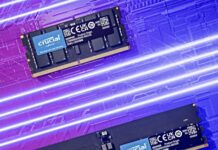Imitation is the sincerest form of flattery, as seen with the Samsung BM1743, a 61.44 TB QLC SSD that competes with Solidigm’s year-old D5-P5336, and Samsung is suggesting a 122.88 TB model could be in the wind.
Sammy has built the BM1743 using 176-layer NAND, its seventh 3D NAND node generation. The Solidigm drive uses 192 layers. The BM1743 is a successor to its BM1733, which came along in 2020 and was a 15.36 TB QLC (4bits/cell) PCIe gen 4 drive using 96-layer technology, Samsung’s fifth generation V-NAND. The “a” version (BM1733a) could, we understand, have up to 32 TB in capacity. Now the BM1743 near doubles that. Its performance numbers are 1,600,000/110,000 random read/write IOPS and 7.2/2.0 GBps sequential read/write bandwidth. It’s highly read-centric.
Solidigm’s D5-P5336 delivers 1,005,000/43,000 random read/write IOPS and its sequential read/write bandwidth numbers are 7.0 and 3.3 GBps respectively. Samsung says “v7 QLC NAND sequential read and write speeds are at least double, and random reads quadruple, those of v5.”
The implication here is that QLC drives can offer TLC SSD levels of performance while providing higher capacity than the 3bits/cell alternative.

Both the BM1733 and BM1743 use the U.2 (2.5-inch) format but the BM1743 adds an E3.S variant which supports PCie gen 5. No performance numbers have been provided.
The BM1743 supports 0.26 full drive writes per day (DWPD) over its warranted life span. This is an improvement on the BM1733’s 0.18 DWPD. The new drive’s power-off data retention increases to three months from the BM1733’s one month.
Samsung suggests upgrading existing BM1733 drives to the BM1743 to get more capacity, faster data transfer to/from the device, and a lower electricity draw.
With Solidigm, Samsung, and Western Digital (SN655) each now offering 60 TB-class SSDs, we can be quite confident that Micron, Kioxia, Solidigm parent SK hynix, and China’s YMTC will offer similar if not greater capacity levels. These drives will surely be presented as offering better-than-disk capacity, performance, and power draw for storing data needed for GenAI training and inferencing.








